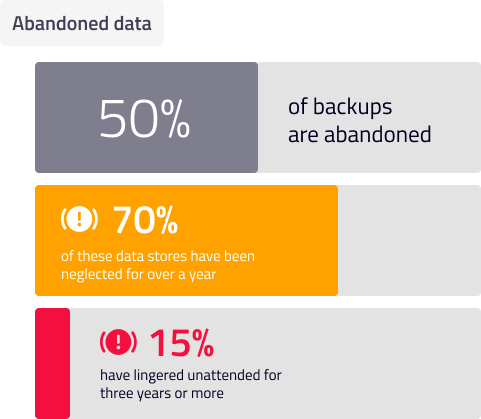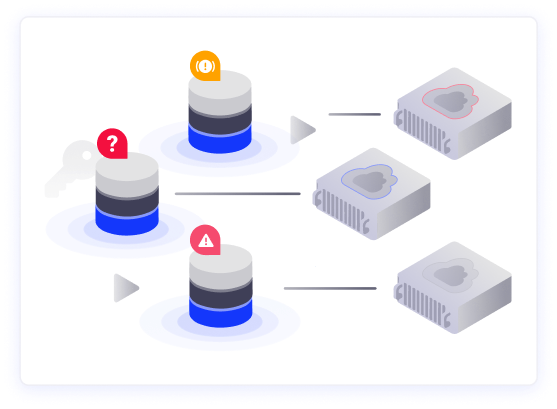Reduce Risk and Cost of Abandoned Data
Find and Manage Data
You Didn’t Know You Had
Normalyze has identified a significant challenge within data management: abandoned data stores. Across various customer bases, it has been found that nearly 50% of backups are abandoned. These are data sources linked to projects or employees that have been terminated and, without a lifecycle or retention policy in place, these snapshots remain, forgotten but still accruing storage costs and posing unnecessary data risks.
Access to these abandoned snapshots is often unmanaged or completely overlooked, leading to potential security vulnerabilities. Furthermore, Normalyze’s insights reveal that over 70% of these data stores have been neglected for over a year, and alarmingly, 15% have lingered unattended for three years or more. The implications are twofold: not only do these abandoned data stores lead to escalating storage costs, they also present a severe risk profile, as unmonitored and outdated data can easily become a target for cyber threats.

What is Abandoned or Stale Data?
Abandoned or stale data refers to information that remains
in storage but is no longer used, accessed, or needed by the organization. This can include files from discontinued projects, data from former employees, or information left behind after migration to new platforms. Such data often lingers undetected due to lack of oversight or inadequate data management policies.

Project Discontinuation


Migration to New Platforms

Lack of Oversight

Redundancy and Duplication

Regulatory and Compliance Changes

Duty to Preserve

Back-ups Without Lifecycle Policy
Why Be Concerned About Abandoned Data?
Abandoned data can significantly increase storage costs and pose security risks. Unused data can be easily overlooked in security protocols, making it a prime target for cyber threats.
Additionally, keeping unnecessary data can complicate compliance with data protection regulations, potentially leading to legal and financial repercussions.
Risk
Solution
| Implement stringent access controls and regular audits to ensure only authorized personnel can access data, reducing the risk of data breaches. |
| Utilize advanced monitoring tools to detect unusual access patterns and secure abandoned data against external attacks. |
![]() Compliance Violations
Compliance Violations
| Regularly review and clean up data stores to ensure compliance with data protection laws, reducing the risk of penalties. |
| Identify and safely decommission unused data stores to save on storage and management costs. Identify data that can be transferred to more affordable storage repositories. |
| Streamline data management practices to improve efficiency and ensure that only relevant, actively used data is maintained. |
Reducing Cost and Risks of Abandoned or Stale Data
1
Identify and Catalog
Use tools like Normalyze to automatically discover and classify abandoned and stale data across your storage environments.
2
Define clear policies for how long different types of data should be retained and when it should be reviewed or deleted.
3
Regular Audits and Clean-up
Schedule regular audits of data stores to identify and address abandoned data proactively.
4
Automate Data Management
Leverage automation for ongoing data management tasks to ensure compliance and minimize human error.
5
Educate and Train Employees
Conduct regular training sessions to ensure all employees understand the importance of data hygiene and compliance with internal data management policies.
Let Normalyze Find Data You
Didn’t Know You Had
OFFERING A powerful solution
By implementing advanced data discovery and classification technologies, Normalyze can pinpoint all data stores including backups and snapshots.
This comprehensive visibility allows organizations to take decisive action. Normalyze aids in cleaning up these abandoned snapshots and supports the establishment of robust data management policies, such as archiving or deleting outdated snapshots. This not only helps in securing the data environment but also results in significant cost savings, potentially amounting to hundreds of thousands of dollars. By leveraging Normalyze’s capabilities, companies can transform their approach to data hygiene, ensuring data stores are not just managed but optimized for cost-efficiency and security.

